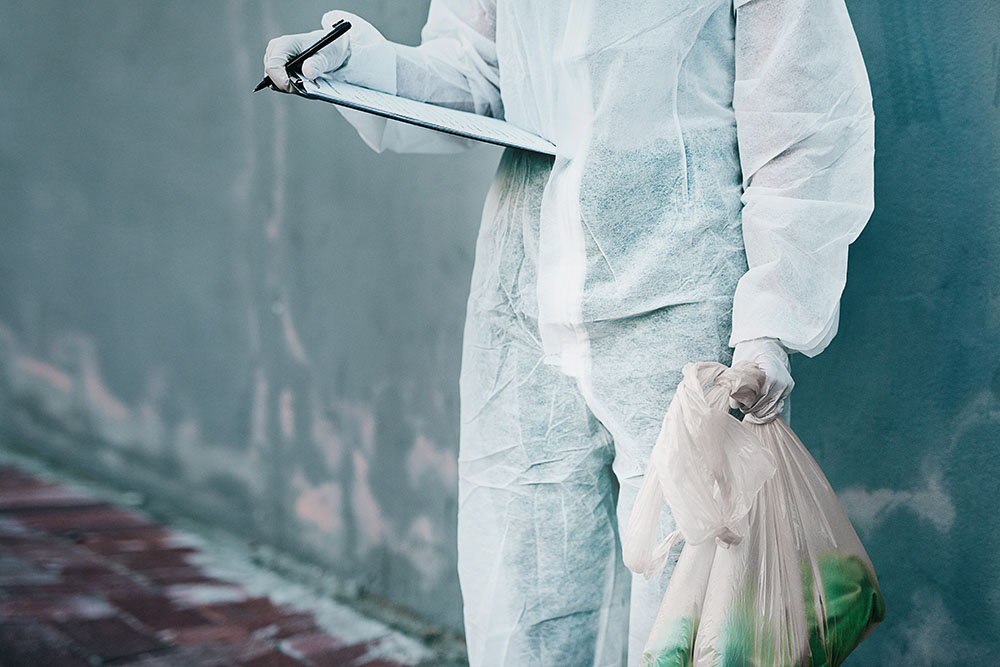What Happens During A Trauma Clean?

CONTENTS
- Understanding the trauma cleaning process
- Initial assessment and planning in trauma cleaning
- Safety precautions in trauma cleaning
- Biohazard cleaning and decontamination
- Legalities involved in trauma cleaning
- Property restoration and support
- Frequently asked questions
- Get in touch
The trauma cleaning process is far from a usual dusting and mopping routine. Professionals wear full-body protective suits and comb through a crime scene with expert precision. Physical cleanliness is just one part of the process, as there is also a layer of legalities to navigate.
Our specialised trauma cleaning services for biohazardous scenes are provided by the professional and trained staff here at ICE Cleaning. Our technicians can restore and clean your property with decontamination measures by implementing advanced technology.
Read on to learn about initial trauma assessments, each step for maximum safety and efficiency, high-risk biohazard cleaning, decontamination techniques, and legalities.
Understanding the trauma cleaning process
Trauma cleaning is a highly specialised service involving more than typical cleaning tools. The complexity of this work lies in its various approaches, including assessment, safety measures, decontamination, and legal aspects.
Assessing the scene
The first step in trauma cleaning involves understanding what they are dealing with. Professionals need to gauge the severity of the contamination present. This initial assessment informs how they plan their approach for effective results.
Safety first approach
Safety is not just about wearing gloves and goggles - it is an intricate part of every action during trauma cleaning. It requires rigorous adherence to personal protective equipment guidelines, safe handling practices, and risk mitigation strategies, protecting cleaners and clients from potential hazards.
Biohazard cleaning and decontamination
Biohazards can include bloodborne pathogens or other biological materials requiring special care during disposal. Following strict procedures helps ensure contaminants are removed effectively without causing further harm to individuals or the environment. Professionals also decontaminate surfaces, using advanced techniques that ensure nothing harmful remains behind once our team leaves the site.
Facing legalities
When meeting legal obligations related to trauma cleaning services, like permission for cleaning, adhering to disposal protocols, or respecting privacy rights, ensuring a stress-free experience throughout the process is key.
Restoration and support
The final phase in the trauma cleaning process is property restoration, including structural repairs and deep cleaning to restore spaces to their original state.
Initial assessment and planning in trauma cleaning
The start of any trauma cleaning process is a detailed assessment. Professionals must fully understand the situation before they begin. This initial assessment involves an evaluation of potential risks to see what hazards are present, like drug paraphernalia or blood.
Safety precautions are identified based on specific circumstances observed during the scene evaluation during this stage. Biohazardous materials might be present, which require protective gear or specialised tools depending upon the extent and type of trauma scene.
A comprehensive cleaning plan comes next after identifying potential dangers and obstacles. This strategy involves planning who will do what tasks, when, and how waste disposal is conducted according to legal requirements.
Trauma cleaning is physically and mentally challenging. It is not something everyone can handle because of the distressing nature of scenes that professionals encounter. Mental preparation is as crucial as physical readiness in this field.
Safety precautions in trauma cleaning
Handling a trauma scene involves the cleaning process and staying safe. Trauma cleaning professionals understand this and take several precautions to ensure everyone is safe and working.
Personal Protective Equipment (PPE)
The first line of defence is always PPE. From gloves and gowns to masks and goggles, every piece is integral. PPE protects workers from biohazards that could cause harm if they come into contact via touch or inhalation.
Specialised respirators are also used to filter the air before you breathe it in, ensuring harmful airborne particles do not enter your body.
Risk mitigation strategies
Risks are everywhere during trauma cleaning, but knowing what those risks are helps professionals stay prepared. By identifying potential hazards beforehand, measures can be implemented to avoid them.
For example, sharp objects can injure cleaners and spread infections when handled improperly. That is why experts use specific tools for picking up sharp debris safely.
Cleaning products used safely
Although strong chemicals can eliminate some germs quickly, some can damage surfaces or pose health risks themselves if misused. Using suitable products properly is integral for effective decontamination without causing further issues.
Proper disposal of biohazardous waste
The cleaning does not end when all visible traces are gone. Anything contaminated requires disposal so it does not pose a threat elsewhere. Professional cleaners bag up and seal biohazardous waste before disposing off-site in a controlled environment.
Biohazard cleaning and decontamination
When a traumatic event happens, the scene often contains biohazards that need careful cleaning. Biohazards can include bodily fluids like blood or vomit, animal waste, mould spores, or any other organic material which poses a risk to human health.
These substances contain harmful pathogens - viruses, bacteria and fungi that can cause diseases if not dealt with.
The first step in managing biohazards is safe removal. Professionals use specialised equipment to get rid of these materials safely without risking their health or further contaminating the environment.
This process also includes correctly bagging and labelling the hazardous waste before transporting it for proper disposal at licensed facilities where they destroy it.
Next is decontamination, which involves using hospital-grade disinfectants designed to kill dangerous microorganisms left behind after initial cleaning efforts. Wearing PPE is crucial to ensure safety during clean-up and decontamination, including gloves, respirators, goggles and full-body suits.
Legalities involved in trauma cleaning
Permission to clean
A cleaner cannot start without permission from the property owner or representative. This permission might be simple for commercial properties, but it becomes complicated in homes after incidents like violent crimes. This is due to privacy laws and respect for personal boundaries.
Disposal of biohazardous waste
Professionals do not just clean hazardous waste up and dispose of it in a local dump site. The Environmental Protection Act 1990 (EPA 1990) sets strict guidelines on how this should be done.
Cleaners must handle potentially infectious material carefully, which could pose serious health risks if mishandled.
Professional responsibilities
As a trauma cleaner, you must follow legal and ethical guidelines protecting everyone involved. For example, you must have training in handling biohazardous materials safely.
This also includes maintaining confidentiality regarding personal information found during cleaning and adhering to General Data Protection Regulation (GDPR) standards.
Property restoration and support
After biohazard disposal, trauma cleaners proceed with property restoration. This can include repairing structural damage or replacing contaminated fixtures and fittings, aiming for complete restoration.
A swift response can make all the difference when dealing with trauma scenes, prioritising rapid remediation without compromising safety or quality standards.
A fast-acting approach minimises disruption while maximising efficiency – from decontamination to final checks before the property is handed back to the owner.
At ICE Cleaning, our methods are based on industry-leading research and follow strict regulatory standards. This guarantees that the clean-up and recovery procedure is visually appealing, ensuring a secure atmosphere for all involved.
We collaborate with local authorities and train all technicians with The National Association of Crime Scene Cleaners. We aim to provide our clients reassurance, ensuring their properties are restored.
Frequently asked questions
What is trauma cleaning?
Trauma cleaning involves professionally sanitising areas affected by accidents, crime scenes, or death. It is a meticulous process ensuring safety and restoring properties.
What is the forensic cleaning process?
The forensic cleaning process tackles biological hazards at crime scenes. This includes removing blood and bodily fluids and decontaminating to ensure it is safe again.
How much is trauma cleaning?
The cost of trauma cleaning varies based on factors like severity, area size, and cleaning time needed.
Get in touch
At ICE Cleaning, our trauma clean-up services cover all biohazardous scenes due to unattended deaths, crime scenes, and more. Our accredited technicians use industry-leading technology and solutions to decontaminate, clean, and restore your property.
Our trauma cleaners are available nationwide, 24/7, 365 days a year. We can be on-site within a few hours of your first call in an emergency, conducting a risk assessment on-site and offering a free, no-obligation quote over the phone. Get in touch today at 0208 066 0360 or enquiries@icecleaning.co.uk.

Speak with me today,
I’m here to help
By asking you a few questions either via phone or email I can immediately provide a realistic estimation of the cost.
You’re in good company. We’ve cleaned for the following commercial clients… View all

Why choose us?
- Cater to a wide variety of cleaning situations
- Nationwide coverage, available 24/7
- Cater to commercial and domestic clients
- Free survey provided prior to quotation
- Emergency response team
- Offer a bespoke service designed to suit all your needs
- All technicians hold professional health and safety qualifications, including BICSc, IOSH, Dewpoint Professional & Safe Contractor
We’re fully accredited
We place best practise, professional expertise and health and safety at the core of our business. We’re fully compliant with all legal obligations. You can view a list of our accreditations below, or visit our Health & Safety page for more information.











-RGB-small.1707319151.jpg)




















